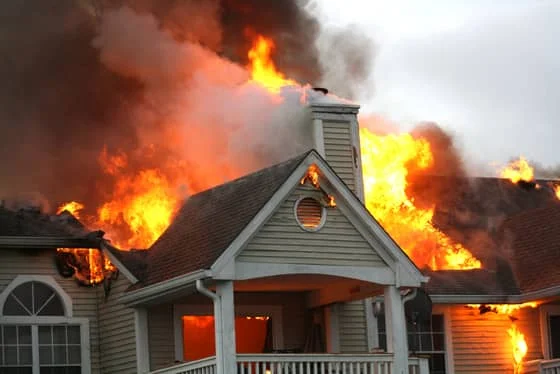Maintaining a safe home means identifying the fire risks associated with everyday household items. Understanding what household items are flammable is crucial, as various objects in spaces like the kitchen, living room, or bedroom could unintentionally ignite and spread a fire. By understanding these items, you can take proactive steps to reduce risks, protect your home, and avoid ever facing the need to sell a fire-damaged house.
This blog offers a detailed examination of objects within different areas of your house that could potentially start a fire. Every part focuses on typical fire dangers and offers useful advice to improve safety and minimize risks. By understanding these dangers, learning what household items are flammable, and taking the right precautions, you can greatly lower the chances of a fire in your home.
Kitchen

Common Flammable Items:
- Cooking Oils and Fats: These can ignite quickly if overheated, especially near open gas flames or stovetops.
- Paper Towels and Napkins: When left too close to heat sources, they can catch fire easily.
- Cleaning Supplies: Many contain flammable chemicals, increasing fire risk.
Safety Tips:
- Store Oils Securely: Keep oils and fats away from direct heat. Use a splash guard to prevent flare-ups.
- Organize Flammable Items: Ensure paper products are stored away from stoves and open flames.
- Ventilate While Cleaning: Adequate ventilation assists in dispersing possibly dangerous and combustible vapors.
Living Room
The living room is another area of concern, often filled with decorative and comfortable, yet flammable, items.
Common Flammable Items:
- Upholstered Furniture and Drapes: They can quickly catch fire, especially if exposed to an open flame.
- Electronics with Faulty Wiring: Defective electronics may spark and heighten the danger of fires.
- Candles and Decorative Pieces: If not handled carefully, they have the potential to spark nearby objects and substances.
Safety Tips:
- Use Fire Retardant Sprays: Use these on fabrics to decrease flammability.
- Check Electronics Regularly: Ensure wiring is intact and appliances are functioning properly.
- Candle Safety: Never leave them unattended and always use sturdy holders.
Bedroom
While bedrooms might appear to be secure, they contain various possible fire risks.
Common Flammable Items:
Bedding and Curtains: They can easily fuel a fire if not made from fire-resistant materials.
- Personal Grooming Products: Aerosol containers are extremely combustible and should be stored with caution.
- Lamps and Nightlights: These can overheat if bulb wattage exceeds the fixture’s rating.
Safety Tips:
- Choose Fire-Resistant Fabrics: Invest in bedding and curtains that reduce fire risks.
- Store Aerosols Appropriately: Keep them in cool, dry places away from heat-prone areas.
- Switch to LED Bulbs: They run cooler and lower the chance of burning.
Garage
Garages typically hold numerous chemicals and fuels that are at risk of igniting, making fire safety a crucial concern.
Common Flammable Items:
- Gasoline and Other Fuels: Highly combustible and dangerous if spilled.
- Paints and Solvents: Can emit flammable fumes.
- Gardening Chemicals: Often contain volatile ingredients.
Safety Tips:
- Approved Containers: Store liquids in containers designed to hold flammable materials.
- Original Packaging: Store chemicals in their designated, labeled containers.
- Proper Ventilation: Make sure your garage has good ventilation to avoid fume accumulation.
Bathroom
The bathroom could contain additional fire risks than expected, mainly because of personal grooming products and small devices.
Common Flammable Items:
- Hair Sprays and Perfumes: Contain alcohol, making them flammable.
- Towels and Bath Mats: Can ignite if too close to heated styling tools.
- Hair Styling Tools: These can overheat if left on.
Safety Tips:
- Store Products Safely: Keep away from heat or direct sunlight.
- Unplug Styling Tools: Turn off and unplug them when not in use.
- Fire-Resistant Mats: Use non-slip, heat-resistant mats to prevent accidents.
Home Office
Home offices contain numerous paper products and electronics, all of which can pose fire risks.
Common Flammable Items:
- Paper Documents and Books: Easily ignite, especially near heat sources.
- Printer Ink and Toners: Flammable if not stored correctly.
- Electrical Cords and Devices: Overloaded power strips can spark and cause fires.
Safety Tips:
- Fireproof Containers: Store essential documents in containers to prevent fire damage.
- Cord Management: Keep wires trimmed and away from heat sources.
- Maintain Devices: Regular checks to prevent overheating and other potential hazards.
Increasing Home Safety
Recognizing combustible items in each room is a crucial measure in safeguarding your house against possible fires. By following the safety guidelines given, you can lower the chances of harm and improve your household’s protection. Consistently reassessing and revising these precautions is essential for keeping a fire-friendly setting.
Taking these measures seriously protects your belongings and ensures the safety of all residents. Knowing what household items are flammable is a key part of this process. To get a thorough evaluation of the safety precautions in your home, think about seeking advice from a fire safety specialist. Give importance to safe practices now in order to ensure a secure future.


 Bedding and Curtains: They can easily fuel a fire if not made from
Bedding and Curtains: They can easily fuel a fire if not made from 